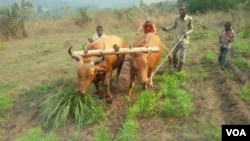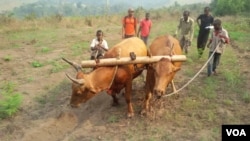Aid workers in the Democratic Republic of Congo are trying to introduce an ancient practice: using animals to transport goods and people.
So-called "animal traction" isn't a Congolese tradition, but the United Nations Food and Agriculture Organization (FAO) says that in areas where roads are bad, it could take a load off people's backs — especially for women.
FAO officials recently sent a film crew to Mbankana, where there’s a training school for draught animals, and then moved them to eastern DRC's North Kivu province, where the organization is promoting the use of bullock carts along many largely unpassable roads.
“We, the older generation, are soon going to depart, and we must pass on our knowledge," Michel Nduako, head trainer at the school at Mbankana, told VOA. "It’s useful knowledge in rural areas. Instead of women carrying heavy burdens, they can yoke the bullocks to the cart, and instead of men working with hoes, they can plough with draught animals.”
Animal traction
A group of students from Kinshasa’s premier state university, UNIKIN, has come to see the training. Nduako introduces them to a pair of bulls.
“The one on the left is Robben, named after the Dutch footballer,” he said, “and the one on the right is Cowbell, because he’s multi-colored.”
Nduako said normally it is recommended to use bullocks — neutered or castrated bulls — for this kind of work, but bulls and cows as well as horses and mules are sometimes used.
The bulls answer to commands, which they are taught by tugging at the their nose rings with ropes.
“Here the animals are trained in French,” said Nduako. “When you say ‘left’, you pull to the left, ‘right’ you pull to the right, forwards, backwards, and stop.”
The bulls are yoked together with a wooden block, but they can still gore the unwary with their horns.
“You see?” said Nduako as Cowbell lunges sideways. “The first rule is prudence.”
Mbankana 's transporation tool
The team sets off plowing but the yoke breaks. It is quickly fixed, however, and Cowbell is replaced with a more docile bull.
“Go! And keep to the furrow!” Nduako shouted.
Mbankana is not a remote village – it’s on the main road 100 kilometers from Kinshasa, and local people mainly use tractors for plowing. Bullocks can’t really compete here, as it costs roughly the same to hire a tractor and driver as to hire a pair of bullocks and their handler, to plough one hectare: $75.
But bullocks are used for transporting goods from outlying villages to Mbankana, according to local teacher, Dieudonne Tchani.
Those villages are far off, he said, and cars and trucks rarely go there; with the bullock cart, however, the villagers can bring their produce to the main road.
VOA went to one of those outlying villages, and saw a broken down cart along the way, and one other cart in the village.
Unresolved issues
Motorbike taxi driver Jean Bosco Mbama told VOA the carts had been very useful to local people, but by 2013 they had fallen into disrepair and no one knows how to mend them. Another problem, he said, was that the bullocks, bought with aid money, were not strong enough.
The aid, he said, was supposed to be spent on bullocks worth $800 each, but in fact they bought ones worth $400 or $500 and pocketed the rest of the money.
FAO spokesman Xavier Farhay said the agency was not involved in animal traction projects in this area.
With its North Kivu project, he said, FAO has trained ex-combatants in animal traction and building carts. Its experts have provided 20 of the recommended types of bullock.
This pilot project funded by South Korea has now ended, though the agency hopes moving forward to expand it.







